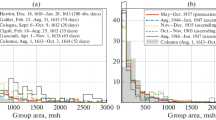Abstract
Historical research at different time scales from 10s to 1000s of years suggests that solar variation may have influences on global climate. Climate change has had significant impacts on cultures during these periods. Very high solar output during the Medieval Optimum would be expected to have particularly large impacts on peoples of that time as sunspot numbers are thought to have reached one third again any values observed in the current century. Certain other impacts can be inferred from modern populations. For example, the higher parts of the solar cycle are associated with greater incidence of skin melanoma.
Similar content being viewed by others
References
Eddy, J. A. (1976). The maunder minimum.Science 192: 1189–1202.
Eddy, J. A. (1977a). The case of the missing sunspots.Scientific American 236: 80–92.
Eddy, J. A. (1977b). Climate and the changing sun.Climatic Change 1: 173–190.
Eddy, J. A. (1980). The historical record of solar activity. In Pepin, R. O., Eddy, J. A., and Merrill, R. B. (eds.),The Ancient Sun. Pergamon Press, New York, pp. 119–134.
Eddy, J. A. (1983a). An historical review of solar variability, weather and climate. In McCormac B. M. (ed.),Weather and Climate Responses to Solar Variations. Colorado Associated University Press, Boulder, pp. 1–15.
Eddy, J. A. (1983b). The maunder minimum: A reappraisal.Solar Physics 89: 195–207.
Eddy, J. A. (1988). Variability of the present and ancient sun: A test of solar uniformitarianism. In Stephenson, F. R., and Wolfendale, A. W. (eds.),Secular Solar and Geomagnetic Variations in the last 10,000 Years. D. Reidel, Dordrecht.
Eddy, J. A., Gilliland, R. L., and Hoyt, D. V. (1982). Changes in the solar constant and climatic effects.Nature 300: 689–693.
Freeman, R. G. (1975). Data on the action spectrum for ultraviolet carcinogenesis.J. National Cancer Institute 55: 1119–1121.
Hays, J. D., Imbrie, J., and Shackleton, N. J. (1976). Variations in the earth's orbit: Pacemaker of the ice ages.Science 194: 1121–1132.
Houghton, A. N., and Viola, M. V. (1981). Solar radiation and malignant melanoma of the skin.J. Am. Acad Dermatology 5: 477–483.
Houghton, A., Munster, E. W., and Viola, M. V. (1978). Increased incidence of malignant melanoma after peaks of sunspot activity.The Lancet 1: 759–760.
Jones, P. D., Wigley, T. M. L., and Wright, P. B. (1986). Global temperature variations between 1861 and 1984.Nature 322: 430–434.
Lamb, H. H. (1977).Climatic History and the Future. Princeton University Press, Princeton, NJ, 38: 435–449.
Link, F. (1962). Observations et catalogue des Aurores Boreales apparues en occident de-626 a 1600.Geophysikalni Sbornik 10(173): 297–387.
London, J., and Angell, J. K. (1982). The observed distribution of ozone and its variations. In Bower, F. A., and Ward, R. B. (eds.),Stratospheric Ozone and Man. Chemical Rubber Co. Press, Boca Raton, pp. 7–42.
National Research Council (1982).Solar Variability, Weather, and Climate. National Academy Press, Washington, D.C., pp. 3–16.
National Research Council (1984).Causes and Effects of Changes in Stratospheric Ozone: Update 1983. NRC, Washington, D.C.
Pounds, N. G. J. (1973).An Historical Geography of Europe 450 BC-AD 1300. Cambridge University Press, Cambridge, pp. 25, 312.
Siscoe, G. L. (1980). Evidence in the auroral record for secular solar variability.Rev. Geophysics and Space Physics 18: 647–658.
Smith, E. V. P., and Gottlieb, D. M. (1974). Solar flux and its variations.Space Science Reviews 16: 771–802.
Stephenson, F. R., and Clark, D. H. (1978).Applications of Early Astronomical Records. Adam Hilger, London, pp. 87–108.
Stuiver, M., and Quay, P. D. (1980). Changes in atmospheric Carbon-14 attributed to a variable sun.Science 207: 11–19.
Viola, M. V., Houghton, A., and Munster, E. W. (1979). Solar cycles and malignant melanoma.Medical Hypotheses 5: 153–160.
White, O. R. (1977).The Solar Output and Its Variation. Colorado Associated Press, Boulder, pp. 1–44.
Williams, G. E. (1986). The solar cycle in Precambrian time.Scientific American 265: 88–96.
Wilson, R. C., and Hudson, H. S. (1991). The sun's luminosity over a complete solar cycle.Nature 351: 6321.
Xu, Zhen-tao, and Jiang, Yao-tiao (1982). The solar activity in the seventeenth century re-assessed in the light of sunspot records in the local gazettes of China.Chin. Astron. Astrophys 2 (English Ed.): 84–90.
Author information
Authors and Affiliations
Rights and permissions
About this article
Cite this article
Eddy, J.A. Solar history and human affairs. Hum Ecol 22, 23–35 (1994). https://doi.org/10.1007/BF02168761
Issue Date:
DOI: https://doi.org/10.1007/BF02168761




